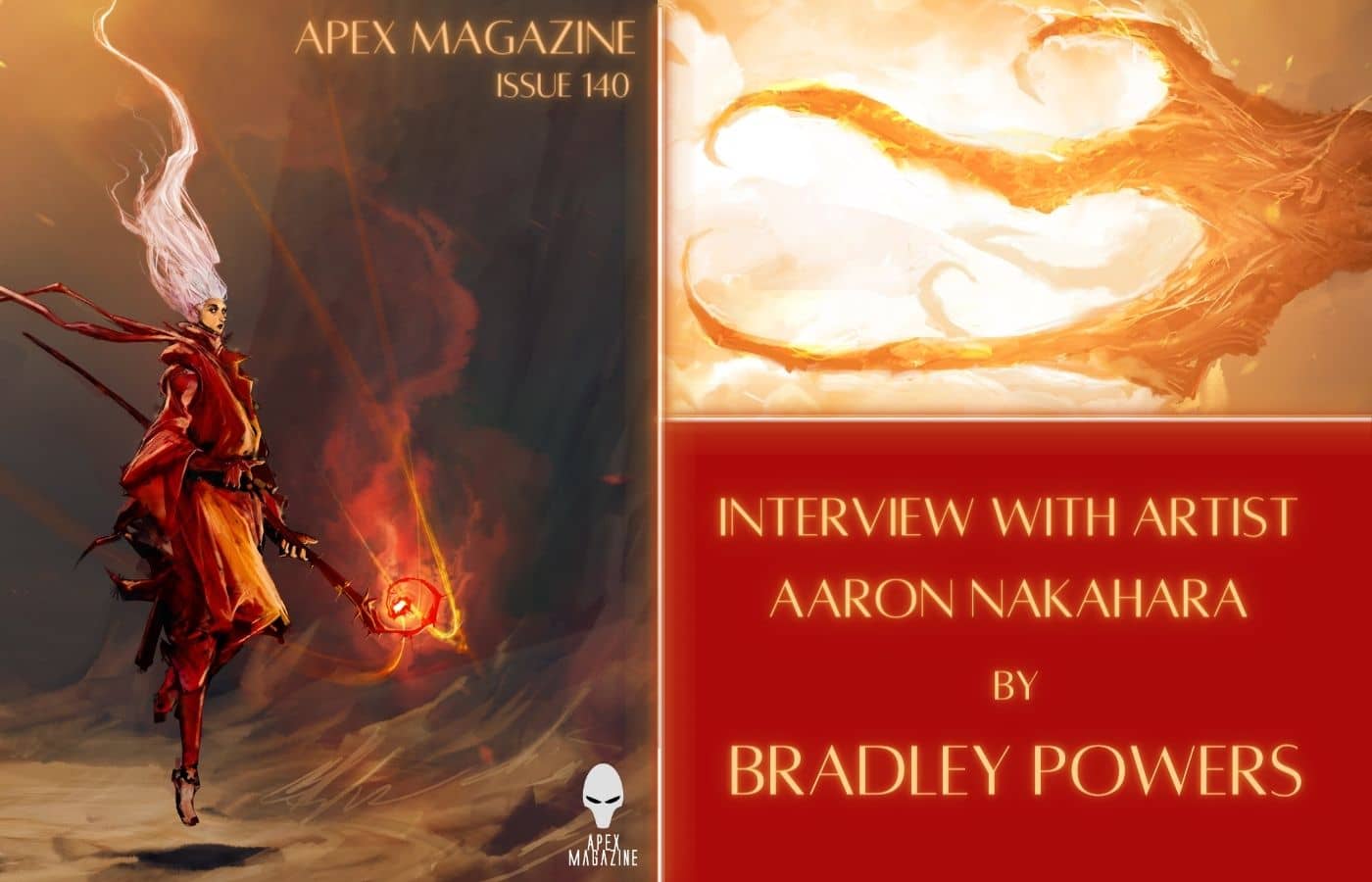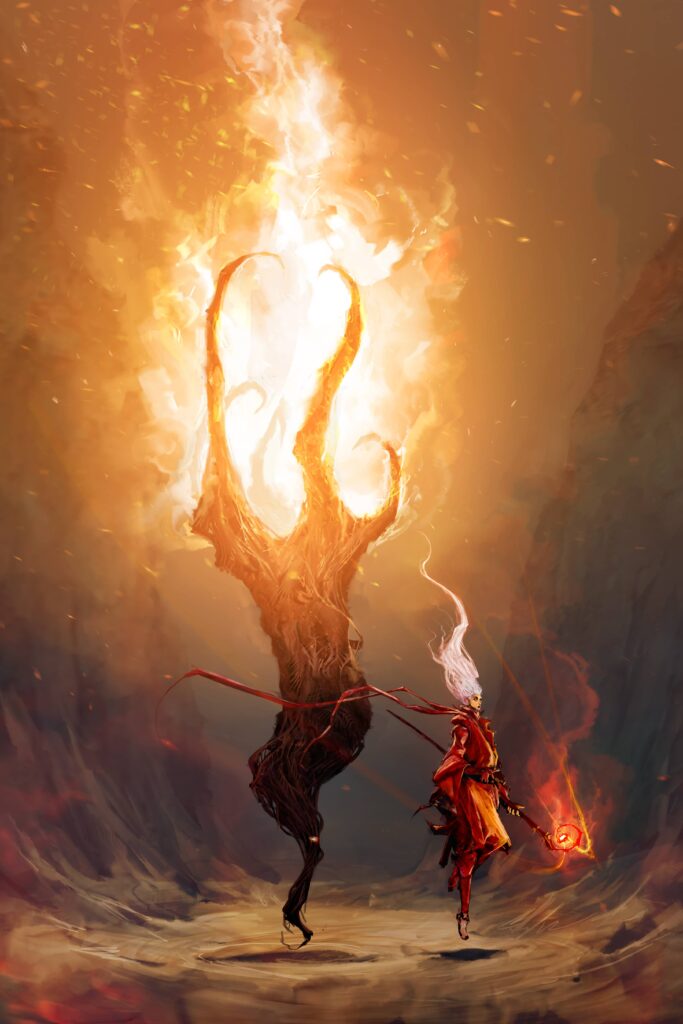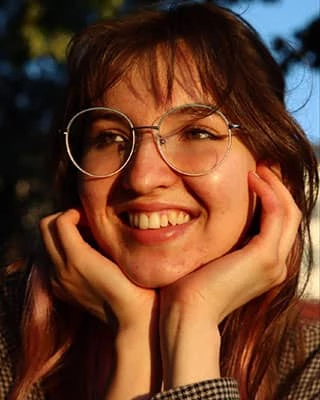
This month’s cover features artist Aaron Nakahara’s “Flame Ward.” Aaron is a fantasy illustrator, designer, and game creator based in Hawaii. Aaron’s work was also the cover of Apex Magazine Issue 92. Check it out here!

Bradley Powers: Your last Apex Magazine cover piece was a character for a game you were working on, Fields of Eleria. How did developing this game change you as an artist and creator?
Aaron Nakahara: It was one of those things that really cemented in me that I absolutely love working on my own projects and in the end that’s my real goal–to just work on my own stuff. Fields of Eleria is an extension of my comic story, but loving card games and now making my own has given me something that I appreciate a lot. It’s encouraged me to create more things for me, not just visual work but also game designs and story ideas. I know I’m not a great designer by any stretch but the things I make, I tend to make for myself and enjoy a lot; if others enjoy it too then that’s icing on the cake.
It does make taking on additional projects a bit more difficult because now it’s a case of, do I want to work on someone else’s ideas or do I want to work on my own? As I’ve gotten older (not necessarily wiser, heh), I’ve found that I’m valuing my own stories and ideas more and more, so unless work comes up for my regular job or a client I’ve done a lot of work for, I’ll most likely pass on it unless it’s very, very compelling.
BP: The majority of your work is very character based. What is your process for creating a character and representing it visually?
AN: This is split up between doing commercial work and personal work. If I’m doing something for a client or for my regular job, I’ll look at the description of what I need to create and then start doing random thumbnails and scribbles on a blank canvas. While I’m doing this, I’ll periodically take a break to dig through my visual library: either things I’ve archived in Pinterest, on a PureRef board, or go through some art books to see if I can get any insights into which direction I should take. Once I feel like I’m starting to get the idea of the design, I’ll sketch out a few more refined thumbnails to send in and from there, I’ll iterate back and forth with my client or art director until we reach a finished design.
For my personal work it’s a little different with some similarities. A lot of personal things I work on are based on ideas and stories I’ve been developing over the last twenty plus years, so I have a fairly large library of sketches and notes already done for them, along with a pretty good idea in my mind of what I want to create. I might browse through some of my boards to see if anything new catches my eye, but generally I work on the piece at a natural pace. I usually keep the happy accidents; I like the happenstance that shows up when I’m working on something that I have a strong vision of. Whatever comes out of that becomes a part of the final image.
Regardless, I think that whenever you make anything you need to be able to tap into that creative well, so the more media you consume, the more experiences you have, the more springboards you can bounce your ideas off of.
BP: How much does the story affect a work of art when you go into it? Would you say the story inspires the art, or the art inspires the story?
AN: This is something that can go either way. The genesis of what you create can have so many different origins since our visual libraries filter into our subconsciousness but so do all the stories that we’ve experienced before. If the story is very compelling then it helps me visualize clearer images of what is being described. I feel like I can see those images with more clarity because I’m more invested in not just the outcome but also in the world building my brain has done.
That said there are times when I’ll sketch something out and the story starts from there, and as I build up and refine the visual idea the tale of where this came from begins to form. Sometimes I’ll see a very striking image which then filters into a hodgepodge of ideas I’ve had brewing, which then becomes more defined and understandable to me. It is something that goes hand in hand, I think.
BP: Recently you’ve done many thirty minute “spitpaint” type works. Explain this process and why it’s effective for artists to practice.
AN: The spitpaint thing comes from a Facebook group I’ve been a part of for a few years called Daily Spitpaint. The administrator who runs the group posts four topics or themes each day and you choose one to speedpaint. Spitpaints are quick sketches done in thirty minutes where you’re not allowed to incorporate any photos into your work, nor use any photo-brushes or photos for textures. You can reference photos while you work but there’s a hard cap of thirty minutes to work.
For myself, it’s been an amazing tool to practice, because you’re set on a very tight time limit for a topic you may or may not be familiar with, and you have to learn to economize your workflow and execution of your painting to fit that time frame. When I first started, I was quite bad at it, but over time it’s been something that’s trained me to think quickly on how to execute an idea. Even if I’m not doing a spitpaint, I find that I generate initial sketches much quicker because I’m used to trying to find those visual solutions at a faster pace. I also use spitpaints as an opportunity to work on things for my comic, so a lot of the fantasy spitpaints I do are explorations for my own comic book.
I do screen recordings of some of my spitpaints (more so before than now because my computer is getting old and bogging down a bit when I record), but one of my favorites is from a couple of years ago.
BP: Based on your Twitter retweets, you seem to have an interest in animation and even 3D animation. Is this something you’d ever like to dabble in yourself?
AN: I do but I understand all too well that it’s faster and easier for me to sketch out ideas and hire someone to bring those to life in a 3D space. I picture a lot of things I do in 3D—like either CG, traditional animation, or live action—but that’s a skillset outside of my own wheelhouse and I know there are others far more capable and faster than I am to realize those dreams. I do have a lot of folks I interact with who are into 3D and 2D animation and modeling, so I like to share cool things I find to inspire them to make more cool things, which will in turn, inspire me more.
BP: In your last interview with us in 2017, you mentioned the importance and camaraderie in online art communities, such as the comments on your DeviantArt page. In the six years since, including the pandemic and how much the internet and art world have changed, do you find these communities more important? How have these communities changed for better or worse?
AN: I feel like those broad communities are more important now than ever, more so with a lot of traditionally-used venues becoming somewhat less inviting to the art community than they were six plus years ago. An interesting thing about the pandemic is that it has shown that many artists can still thrive in isolation because they interact with their communities and with each other. Having those venues helps foster creativity beyond just what you come up with on your own. It was interesting to see when we were all locked away from one another that artists soldiered on because that’s just what a lot of us did. Squirreling away and working as we always did, chatting with folks, messaging our peers.
Though there are aspects which aren’t as savory. Some communities seem to have become a little more insular—more to themselves. Maybe they want to focus more specifically on a particular facet or discipline within the art world, but some places don’t feel quite as welcoming as they once did.
Overall though I think it’s been a net positive, especially over the last few years during the pandemic and now as we’re working our way out of it. More folks were at home and discovered that there were places online where they could hang out and become a part of something they enjoyed and loved. In a way, it was a very human experience even if we weren’t face to face.
BP: Thank you so much, Aaron, for sharing your unique perspective of game design and online communities with us. Find more of Aaron’s work at DeviantArt and Twitter, and check out Fields of Eleria here!










